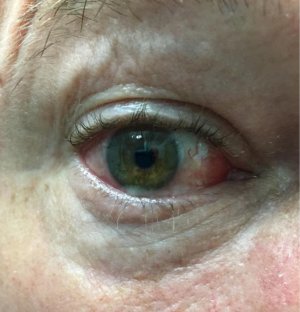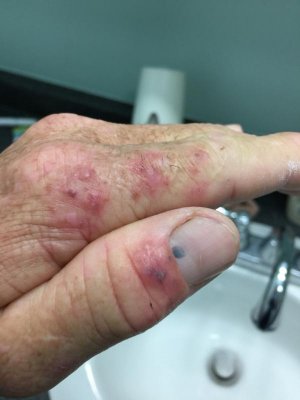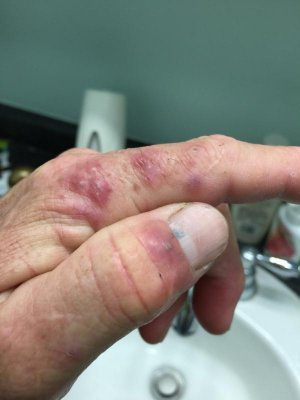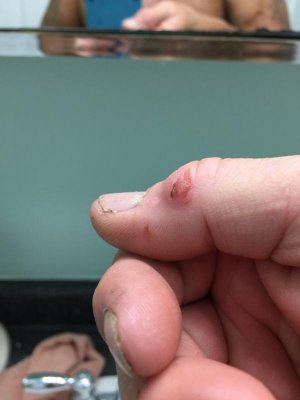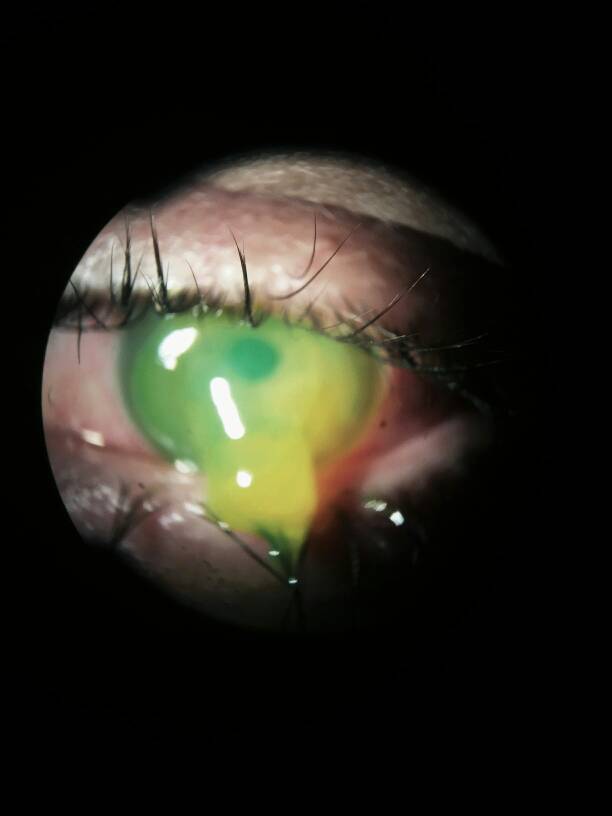well, would you look at that!
well, would you look at that!
The doctors at U of M say, there was still an unusual inflammation of the cornea, but that they still didn't feel there is any permanent damage to the eye or eyesight. I had to trust them at this point and hope they were right.
06/04/2010 - It's been 3 weeks now since the incident. my cornea is still slightly inflamed. Dan
thanks for posting, got me reading some stuff. being a non-allergic type person, i wanted to see if this was immune mediated hypersensitivity or by what mechanism this happed (i wanted a reason to not need gloves). i'll post the highlights from some peer reviewed journals below. most notably: anything in the tank can have PTX in/on it. Even Dino's. There is even a syndrome for death from eating seafood with PTX and other suspected toxins (Haff disease).
[This persone needed an amniotic tissue transplant to save the cornea, you sir, were lucky...]Dangerous reef aquaristics: Palytoxin of a brown encrusting anemone causes toxic corneal reactions.
Ruiz Y, et al. Toxicon. 2015.
Abstract
Although frequently observed in domestic saltwater aquariums, literature on exposure to palytoxin (PTX) of encrusting anemones (Zoanthidea) kept in aquariums is rare. Handling these animals for propagation purposes or during cleaning work can lead to dermal, ocular or respiratory contact with the PTX generated by some Zoanthids. The present study describes a case of ocular exposure to liquid from a Zoanthid, which led to corneal ulcers. The patient also suffered from systemic symptoms of dyspnea and shivering and a suspected rhabdomyolysis, which required monitoring in the Intensive Care Unit. After symptomatic treatment provided insufficient results, the corneal ulcers improved with an amniotic membrane transplantation. A review of the literature regarding ocular exposures to this diverse order of Hexacorallia reveals that severe and systemic symptoms can develop with minimal contact.
Human risk associated with palytoxin exposure.Review article.
Deeds JR, et al. Toxicon. 2010.
Abstract
Palytoxin (PTX) was first isolated from the zoanthid Palythoa toxica. Evaluation of PTX toxicity using various animal models determined that PTX was extremely potent through intravenous, intraperitoneal, and intratracheal exposure. PTX was less potent by direct intragastric exposure. PTX also caused significant, non-lethal effects through dermal and ocular exposure. PTX and PTX-like compounds have now been found in additional zoanthid species, red alga, a sea anemone, and several dinoflagellates. PTXs are found throughout certain reef associated food webs, including in fish and crabs responsible for human illness and death. Many of the organisms found to contain PTXs in the environment are also sold in the home aquarium trade, and recent evidence suggests poisonings have occurred through exposure to these organisms. Due to co-occurrence with other seafood toxins, such as ciguatoxins, saxitoxins, and tetrodotoxin, it has been difficult to assess the true risk of PTX poisoning through seafood consumption in humans, but limited cases have been well documented, some involving human fatalities. Recent evidence also suggests that humans are negatively impacted through PTX exposure by inhalation and dermal routes. Continued research into the distribution and occurrence of PTX and PTX-like compounds both in seafood and marine organisms sold in the aquarium trade appears warranted.
[More evidence, No antidote]Case series: inhaled coral vapor--toxicity in a tank.
Sud P, et al. J Med Toxicol. 2013.
Abstract
INTRODUCTION: Palytoxin (PTX) is considered a severe marine toxin. Although rare, reports of human exposure from consumption of PTX have described significant morbidity and mortality. PTX is the suspected agent in Haff disease, in which rhabdomyolysis occurs within 24 h of eating contaminated fish such as buffalo fish. PTX is primarily present in soft corals or in dinoflagellates, and it can contaminate crustaceans and other fish as it bioaccumulates up the food chain. Only 23 cases have been reported in the USA, including two recent cases in New York City. Reports of inhalational exposure to PTX are uncommon.
CASE REPORTS: We describe a case series of six patients, including four adults and two children, with inhalational exposure to PTX aerosolized from Palythoa corals. Their symptoms included some degree of respiratory involvement, myalgias, paresthesias, low-grade fevers, and gastrointestinal symptoms. Fortunately, there were no serious outcomes and all patients survived without sequelae.
DISCUSSION: Although rare, exposure to palytoxin is not restricted to people visiting marine environments because of Palythoa coral in some home aquariums. Routes of exposure go beyond consumption of fish that feed on the coral and include dermal as well as inhalational exposure. Palytoxin exposure should be considered in the differential diagnosis of patients who own or work with fish tanks and present with symptoms that include respiratory complaints, myalgias, neuromuscular dysfunction, hemolysis, and cardiac toxicity. There is no known antidotal therapy and treatment should focus on meticulous supportive care.
[this article is an animal mode of "HOW?", interestingly irreverible cardiac damage also occurs]Toxicity of palytoxin after repeated oral exposure in mice and in vitro effects on cardiomyocytes.
Del Favero G, et al. Toxicon. 2013.
Abstract
Palytoxin (PLTX) is a highly toxic hydrophilic polyether detected in several edible marine organisms from intra-tropical areas, where seafood poisoning were reported. Symptoms usually start with gastro-intestinal malaise, often accompanied by myalgia, muscular cramps, dyspnea and, sometimes, arrhythmias. Monitoring programs in the Mediterranean Sea have detected PLTX-like molecules in edible mollusks and echinoderms. Despite the potential exposure of the human population and its high toxic potential, the toxicological profile of the molecule is still an issue. Thus, the effects of repeated oral administration of PLTX in mice were investigated. Seven days of PLTX administration caused lethality and toxic effects at doses ≥ 30 μg/kg/day. A NOAEL was estimated equal to 3 μg/kg/day, indicating a quite steep dose-response curve. This value, due to the limited number of animal tested, is provisional, although represents a sound basis for further testing. Macroscopic alterations at gastrointestinal level (gastric ulcers and intestinal fluid accumulation) were observed in mice dead during the treatment period. Histological analysis highlighted severe inflammation, locally associated with necrosis, at pulmonary level, as well as hyper-eosinophilia and fiber separation in myocardium. A cardiac damage was supported by the in vitro effect of the toxin on cardiomyocytes, indicating a severe and irreversible impairment of their electrical properties: electrophysiological recordings detected a progressive cell depolarization, arrest of action potentials and beating.
I will be wearing barriers and eye protection now...
thanks.



